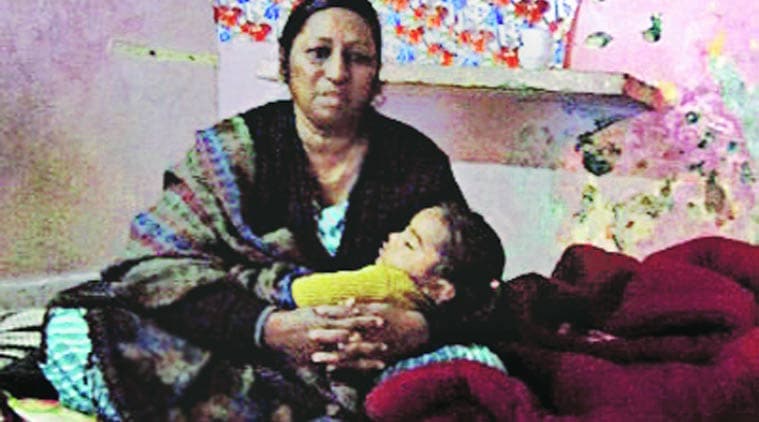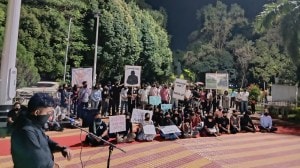Stay updated with the latest - Click here to follow us on Instagram
‘When so many karamcharis are dying, someone should take note’
In absence of proper gear and hazardous work conditions, death rate among safai karamcharis is high.
 Mahenderi at her house in Sector 15, Chandigarh. (Source: Express Photos)
Mahenderi at her house in Sector 15, Chandigarh. (Source: Express Photos)It was the morning of September 11, 2014. For Mahinderi, 50, an MC safai karamchari working in Sector 15, where her 26-year-old son was one of her fellow workers, it was a usual day at work. She saw her son taking a short break from work, and then chatting and laughing with his colleagues, until he suddenly collapsed and died, which doctors said was due to cardiac arrest.
It was déjà vu for Mahinderi, who had seen her husband die in a similar way at the same age 27 years ago, following which she was given a job by the MC on compassionate grounds. Her son was nine months old then, and her grandson is 18 months old now. However, this time, none of her family members was given a compensatory job.
“The world crashed before my eyes twice. I’m myself undergoing treatment at PGI for heart-related problems. I can’t say whether or not my son and husband died due to their work, but when so many karamcharis are dying, somebody should take notice. We make this city beautiful, clean all the germ-infested filth, and bear the stench, yet we are not even provided basic gear like gloves and mask to keep off the dust. We’re given soap, oil and jaggery but I cannot even have the latter as I’m diabetic,” lamented Mahinderi, who lives in Sector 15.
In the absence of adequate protective gear, and the hazardous working conditions, the mortality rate among safai karamcharis is unusually high. More than 225 safai karamcharis have died in the last six years, mostly due to heart-related problems, asthma and tuberculosis. The workers say that many of them have also died in on-duty road accidents.
This means that since 2009, around 38 workers have been dying per year on average, excluding the contractual employees. During this time, their total strength ranged from 2,800 to 1,400. Thus, the death rate per thousand workers per year roughly ranges from 13 to 27, which is several times higher than the crude death rate of 4 per 1,000 persons per year in Chandigarh, according to the website of the National Health Mission.
The issue has been brought to the fore by the recent prolonged strike launched by the Safai Karamchari Union, during which protesters demanded jobs to dependents of workers who died since 2009 when the UT Administration stopped giving them employment on compassionate grounds.
“A large number of workers dying during duty are aged below 40. On Monday, a worker aged around 35 collapsed while working in the Industrial Area and died. Another time, a worker fell down from the sanitation tractor-trolley he was sitting on, and got crushed under the wheels of trolley. Sometimes, workers have to collect really hazardous garbage, especially in slums and colonies. They have to inhale hazardous gases emanating from the rotting garbage,” said Brijpal Mehrolia, the union’s chief advisor.
MC Medical Officer of Health P S Bhatti said, “I’m busy right now. But you can take my comment on Wednesday.” Another MC official said, “It is not just the garbage. The high death rate among the workers is also due to their socio-economic background. We’re providing soap, oil and jaggery to them and for the last several months, gloves and masks are being provided to some of the workers.”
On Sunday, the commissioner held a meeting with the protesters, whose minutes read, “Keeping in view higher death rate among safai karamcharis, the matter of providing jobs to their dependents has been referred to the UT administration… The policy prevalent in the MCs of Delhi will be examined.”
Former mayor Subhash Chawla said, “As per the service rules, the MC holds regular health check-up camps for the workers and they are also vaccinated against certain diseases. Whenever they raise any demand, we look into it on a priority basis.”
AAP takes up their cause
On tuesday, a delegation of AAP members met Advisor Vijay Dev and asked him to look into the matter. “There are always occupational hazards related to the job. All karamcharis are at high risk… Three months ago, a safai karamchari died after inhaling toxic gas from a manhole near the lake. We suggest that they be provided with industrial safety gloves… and should also be given periodic training on how to safeguard themselves against diseases,” said a statement by the AAP.
Study commissioned
The Brihanmumbai Municipal Corporation recently commissioned a study to assess the reasons for the death of 1,386 sanitation workers, out of a total of 35,000, in the last six years.







